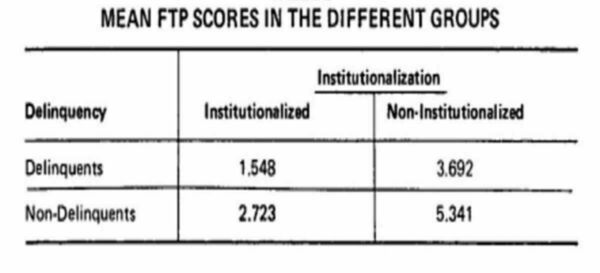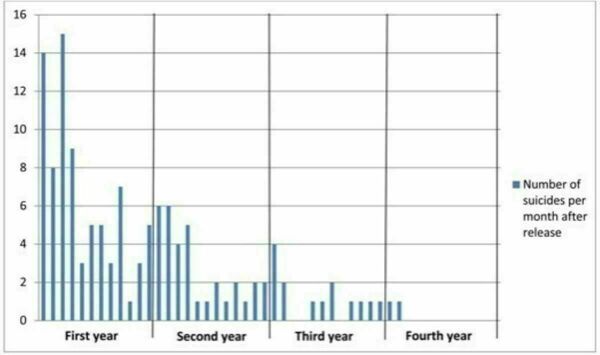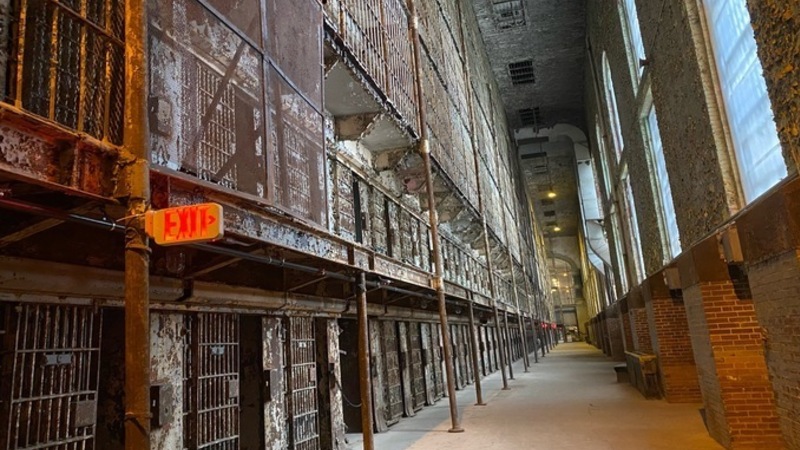Widely considered one of the greatest films of all time, The Shawshank Redemption is a timeless tale of hope, friendship, justice, and power. While the film ultimately acts as a beautiful display of almost unrealistic hope, it is also extremely harrowing in its depiction of life both within and beyond the walls of Shawshank Prison. Prison violence and the deterioration of mind are certainly important perpetuations of this horror, but perhaps the most depressing yet simultaneously terrifying aspect is the effects of the institutional nature of the prison on its inhabitants. Throughout the film, the idea of becoming institutionalized is always on the mind of its characters, and is an especially prominent theme upon the release of one of the oldest prisoners, Brooks. After he is released from Shawshank, Brooks is thrown into a world that continuously developed without him, thus leaving him behind. He gets a job at a grocery store, but faces constant criticism and extreme loneliness. He contemplates committing a crime in order to send himself back to prison, but ultimately decides to commit suicide. Upon receiving a letter from Brooks detailing his pain outside of Shawshank and his plan to end his life, some of the prisoners condemn his actions. On the other hand, Red, one of the main characters of the movie, sympathizes with his old friend, saying, "These walls are funny. First you hate them, then you get used to them. After long enough, you get so you depend on them. That is ‘institutionalized’” (The Shawshank Redemption). In this quote, Red’s recognition of the reality of the prisoners’ reliance on the structural nature of Shawshank becomes clear. When Red is released, he works at the same grocery store at which Brooks works, in which his manager must tell him that he does not need permission to use the bathroom. Red explains that he cannot physically use the bathroom without asking permission, thus demonstrating the dependency on order and institution which he attained during his imprisonment. This scene, in addition to the death of Brooks, are two concrete illustrations of institutionalization for the characters of the film.
Even though The Shawshank Redemption is a work of fiction, the issue of institutionalization is not. Institutionalization, or “the process by which inmates are shaped and transformed by the institutional environments in which they live,” is a byproduct of imprisonment that has affected and continues to affect the currently and the formerly incarcerated all over the world (Haney). It is institutionalization that creates the dependency experienced not only by the fictional characters of the fictional Shawshank prison, but also in the real lives of real people. Therefore, institutionalization’s imposing effects on the lives of prisoners begs the following question: can former prisoners truly “get busy living” or does institutionalization force them to “get busy dying” after being released (The Shawshank Redemption)? Prison institutionalization–an unfortunately intrinsic part of the United States prison system–has detrimental psychological effects on current and former prisoners, thus also harming the communities to which they must re-adjust and therefore requiring a rehabilitative solution.
In general terms, institutionalization is described as “the process by which inmates are shaped and transformed by the institutional environments in which they live'' (Wymore and Raber). This does not only apply to the lives of people while they are in an institution. Rather, it also applies to their lives when they leave the institution of which they were a part. This is because the dependency created through being institutionalized has lasting consequences for the mental health and well-being of those who are institutionalized. While institutionalization can occur in any institutional environment–schools, the military, mental hospitals, among others–one of the most severe cases of this phenomenon occurs in prisons due to the strict, punishment-focused nature of prisons. It is important to note that “Prisons do not, in general, make people ‘crazy’", but still manage to cause “psychological harm” that can, in turn, negatively affect not only prisoners, but also the communities to which they return (Haney 5). This means that, in most cases, institutionalization does not make reintegration into society impossible. Even so, it still often remains a difficult process of transition for many prisoners.
One of the biggest obstacles for prisoners to overcome upon release is a dependency on the structure of a prison: “prisoners may adjust to the muting of self-initiative and independence that prison requires and become increasingly dependent on institutional contingencies that they once resisted” (Haney 7). This means that since prisons take away their freedom, prisoners often become dependent on the order that the prison provides. This order only comes from the taking of freedom–the epitome of what the modern prison system has become. In terms of institutionalization, this lack of freedom for a prolonged period of time leads former prisoners to feel a lack of direction or a sense of being overwhelmed after they are released. From this order and punishment also comes distrust among inmates while they are in prison. Prisons are generally dangerous places where prisoners must be “ever-alert for signs of threat or personal risk” (Haney 7). Because of this, prisoners often cannot trust the other prisoners with whom they live. After being released from prison, this distrust often leaks into their lives in the outside world. This has the possibility of creating a sense of isolation and a lack of connection with those around them within and outside of prison. Self-isolation often results from this since “some prisoners learn to find safety in social invisibility by becoming as inconspicuous and unobtrusively disconnected from others as possible” (Haney 9). This indicates that, while in prison, many prisoners adapt to the nature of prison by socially disappearing in order to protect themselves. Again, since they are so used to this condition while incarcerated, released prisoners often face this sense of social withdrawal and isolation outside of the structured, dangerous institution of the prison. Finally, the intensity of the prison–as shown through its danger and taking of freedom–often causes post-traumatic stress in prisoners (Haney 11). Personal history can contribute to this, but the additional stress of being in prison can exacerbate it. As with the other psychological effects described, this stress can also affect everyday life after prison, making readjustment more difficult. Thus, through all of these psychological effects, it becomes clear that this process damages not only the lives of prisoners within prisons, but also within the communities to which they so desperately need to readjust. These effects inhibit this readjustment, therefore also harming those same communities. This is because self-isolation and distrust hinder relationship development between the formerly incarcerated and those around them.
Of all of the psychological consequences of institutionalization in the prison system, one of the most serious is an adverse ramification on Future Time Perspective for inmates. Future Time Perspective is the amount/quality of life an individual sees themself having left to live. Since Future Time Perspective is a measurement of one’s view of their future, a life-altering prison sentence adversely affects it. Simha Landau, a researcher from Hebrew University in Jerusalem, found in his study that “prisoners plan for shorter periods ahead than soldiers” and “...the closer the subjects are to their release, the shorter the range of their future time perspective” (Landau 29-31). The fact that this Future Time Perspective shortens near an inmate’s release indicates that prisoners understand their institutionalization and the idea that they will face many struggles in their re-adjustment to society.

In the study, Landau compares institutionalized delinquents to those of other institutions (such as the military) and found that those who are imprisoned have a shorter Future Time Perspective, indicating that not only does institutionalization in general have a negative effect, but that the institution of the prison has this same result. As shown in Figure 1, institutionalized delinquents have the lowest Future Time Perspective (1.548 years) of all other groups (Landau 29). This demonstrates that imprisonment in relation to institutionalization negatively affects Future Time Perspective. Thus, prison institutionalization creates a lack of optimism for the future for both the currently and formerly incarcerated. It is unlikely that, after becoming institutionalized, prisoners can see a life for themselves outside the walls of the prison, as evident from Landeau’s study. In another study, various inmates were interviewed about their view of life after incarceration. One prisoner said, “I can't function on myself. I have to be told what to do, how to do it, when to do it” (Crane, Pascoe 316). This, and the rest of the study, in addition to Landau’s study, demonstrate the severity of institutionalization and that prisoners are aware of the institutionalization that has occurred to them. Their generally pessimistic Future Time Perspectives likely contribute to this since they measure prisoners’ life quality. If a prisoner becomes institutionalized, it is likely that they do not have a vision or hope for their future, causing this fear of re-acclimation.
In addition to these psychological consequences, time in prison also causes the formerly incarcerated to be more prone to committing suicide. In fact, the suicide rate for the formerly incarcerated in Sweden was found to be 18 times greater than that of the general population.

Furthermore, as demonstrated in Figure 2, this suicide rate is higher for the formerly incarcerated who are within a year of their release than that of those who are within two years, which is higher than the suicide rate of those who are within three years of release, and so on (Haglund et al.). The fact that institutionalization causes an immediate shock to this population upon their immediate release back into society contributes to this decreasing rate. Over the years, prisoners are more likely to adapt to society and become less dependent on the structure of the prison as an institution, thus causing their Future Time Perspective to increase and therefore decrease the suicide rate of that population. Overall, however, this data demonstrates that institutionalization has detrimental effects on the mental health of prisoners, especially right after their release from prison. This institutionalization is not only harmful to prisoners, but it also causes harm to the prisoners’ communities; by committing suicide, they take themselves, their talents, and their potential away from their communities.
On a larger scale, mass incarceration is a development that plagues the criminal justice system and thus also contributes to a prisoner’s institutionalization. In the United States, mass incarceration has become an increasingly large systemic issue–with rates increasing by about 500% since 1970 (“Criminal Justice Facts”). Clearly, the prison system has grown immensely in the country, especially in recent years. In theory, these prisons are meant to keep communities around the country safer and happier. However, in practice, due to such high incarceration rates, the prison system ultimately harms these communities due to the fact that not only are many people wrongly incarcerated, but they are also incarcerated for immense amounts of time. In this way, prisons harm communities since they take large portions of the lives of their prisoners and institutionalize them in a way that they are unable to adapt back to their communities upon release.
Until the 1970s (which is also when mass incarceration began to increase so greatly), there was more of a focus on rehabilitation in the prison system. At this time, “Prisoners were encouraged to develop occupational skills and to resolve psychological problems--such as substance abuse or aggression-–that might interfere with their reintegration into society” (Benson). The institutions of the time focused more on the well-being of prisoners. Because of this, the prison system benefitted not only its prisoners, but also the communities it supposedly sought to better. This is due to the fact that prisoners would leave prison with skills and with assistance that would allow them to have a better re-adjustment to their society, allowing them to become better citizens in their communities. However, in terms of the current prison system, this is not the case. Today, with the prison system’s size, there is less ability to focus on mental health rehabilitative services. While many prisons have mental health services, they often do not have an adequate amount to truly be effective due to the reality of mass incarceration. Without these rehabilitative services, “When released...[prisoners] have few of the social or occupational skills necessary to succeed in the outside world” (Benson). This demonstrates that as prisons have brought punishment to the forefront of their services, there has been an increased sense of institutionalization of the prisoners. This focus on punishment can be due to the fact that there are so many more people living in prisons and therefore needing their services. This causes the quality and quantity of rehabilitative service for prisoners to decline or be spread too thinly. A solution to the problem of institutionalization would be a decrease in mass incarceration. With fewer people incarcerated, prisons would be able to better-focus their resources on a smaller group of people, thus allowing prisoners to receive better treatment and to increase their chances of becoming the productive members of society that the prison system should theoretically intend to make them.
Not only is institutionalization a criminal justice issue, but it is also a racial justice one. Even though institutionalization itself does not discriminate, as it is a natural, psychological process, the prison system of the United States does. This is because racism in the criminal justice system exists due to incarceration, which is on what institutionalization depends. “As of 2001, one of every three black boys born in that year could expect to go to prison in his lifetime, as could one of every six Latinos—compared to one of every seventeen white boys” (Porter and Ghandnoosh). This is especially jarring considering the fact that Black Americans and Latino Americans make up only 13.4% and 18.5% of the United States’ population respectively (“U.S. Census Bureau”). The incarceration rate of these groups, in combination with the proportion of the population that they represent, indicates that imprisonment disproportionately affects them, thus demonstrating the problem of racism in the criminal justice system. Because of this, institutionalization also disproportionately affects these populations due to the fact that more people from these populations are incarcerated and therefore face the problem of institutionalization. Not only are people of color more likely to be incarcerated than white people, they are also more likely to receive longer prison sentences. In fact, Black men are likely to be given a sentence that is 20% longer than a white man’s sentence for the same crime (Ingraham). In terms of institutionalization, the fact that the sentences of Black men are longer than white men means that Black men face a more severe dependency on the prison structure because a lengthier sentence indicates an increase in institutionalization: “Incarcerated people and their advocates have long argued that lengthy sentences, in particular life without parole, constitute a form of death by incarceration” (Crane and Pascoe). Because of the racism of the criminal justice system in general, people of color, and specifically Black men, are more likely to be affected by this “death by incarceration” than white people. This indicates that institutionalization–being an issue of criminal justice–is also one of racial justice due to its disproportionate alteration of the lives of people of color.
With all of the evidently negative impacts of institutionalization on both prisoners and on their communities, one must wonder whether or not there exists a solution to the problem. Since the prison system is such a vast, complex structure, there are indeed many solutions to the problem of institutionalization. Broadly speaking, a decrease in mass incarceration would help solve this issue. As already mentioned, mass incarceration has caused rehabilitative services to be spread too thinly among the increasingly large prison population. There are a lot of factors and changes that can contribute to this necessary decrease in mass incarceration. One such solution is not giving prison time for lower-level crimes (smaller drug-related crimes, smaller cases of theft, etc.). Instead, first-time offenders of these crimes can be put on probation, be given access to mental health or addiction services, or be given community service requirements. This would help decrease the number of people in prison substantially since so many of the people in prison are there due to these less-severe crimes. Another potential solution to mass incarceration is decreasing prison sentences. This would allow current prisoners to be released more quickly, thus allowing the prison population to decrease. Additionally, the decreasing of these sentences would lessen the intensity of their dependency on the prison.
Apart from decreasing mass incarceration, there are some other, smaller-scale solutions to institutionalization. Fortunately, some of these solutions have already been implemented in prisons around the United States. An example of this is Tim Robbins’ (who plays Andy Dufresne in The Shawshank Redemption) Actor’s Gang Prison Project. This program consists of Robbins and many other Hollywood actors traveling to prisons around the state of California and giving acting lessons. Robbins says, “We’re starting to get some very encouraging numbers as far as recidivism and in a reduction in violent offenses within prison. And we’ve had wardens tell us that it’s changed the culture of prison” (Reed). This is due to the fact that through acting, prisoners learn to better-express and better-control their emotions. In terms of institutionalization, programs such as this one help to mitigate the emotional isolation and distrust that many prisoners may face. This is because this program helps make prisons safer and also helps prisoners to establish connections with one another.
Another potential solution to institutionalization is making available community college classes in prisons. In classes, prisoners can learn valuable skills and earn degrees to make them more likely to attain better career possibilities after their imprisonment. Additionally, these prisoners can also become more familiar with the society from which they have become separated, thus making the process of reintegration an easier one. Like the case with the Actor’s Gang Prison Project, some prisons around the United States have already begun to implement this solution into their rehabilitative services. An example of this exists in Dayton, Ohio, in which women in the Dayton Correctional Institute have the opportunity to take classes at Sinclair Community College. These women can “learn the types of skills employers demand of workers in middle-skill professions” (Smith). This indicates that through this education, the women are more likely to succeed on the outside of the prison, thus reducing the negative effects of institutionalization. This kind of programming would likely require some sort of state or federal funding to become more largely effective, since currently, most prisoners must pay for college classes themselves (Smith). With that said, however, it would be an extremely beneficial concept in which to invest. This is because education can only enhance the communities to which the prisoners return, as not only has it been proven to reduce rates of recidivism, but it also brings people into the workforce and thus into service to the community that they would have otherwise been unable to reach. In fact, a 2013 study from RAND found that taxpayers actually “save $5 for every $1 spent on prison education” through reducing recidivism (Smith). This shows that a decrease of institutionalization by means of community college benefits the prisoners themselves, taxpayers, and society.
Institutionalization is an issue that has unfortunately become essential to what it means to be a current or former prisoner in the United States. It has revealed itself to be as intrinsically related to the prison system as mass incarceration, and thus requires some solution so that former prisoners can become more easily acclimated to life outside of the walls on which they are forced to grow dependent. This solution is ever necessary as mass incarceration and racism in the criminal justice system remain pressing issues within the United States. All in all, because of the institutional nature of this prison structure, Red is unfortunately correct in saying: “They send you here for life, that’s exactly what they take” (The Shawshank Redemption).
Works Cited
Benson, Etienne. “Rehabilitate or Punish?” Monitor on Psychology, American Psychological Association, vol. 34, no. 7, 2003, p. 46, https://www.apa.org/monitor/julaug03/rehab.
Crane, Johanna T., and Kelsey Pascoe. “Becoming Institutionalized: Incarceration as a Chronic Health Condition.” Medical Anthropology Quarterly, vol. 35, no. 3, 2020, pp. 307–326, https://doi.org/10.1111/maq.12621.
“Criminal Justice Facts.” The Sentencing Project, 3 June 2021, https://www.sentencingproject.org/criminal-justice-facts/.
Haney, Craig. “The Psychological Impact of Incarceration: Implications for Post-Prison Adjustment.” The Assistant Secretary for Planning and Evaluation, 30 Nov. 2001, https://aspe.hhs.gov/reports/psychological-impact-incarceration-implications-post-prison-adjustment-0.
Haglund, Tidemalm, D., et al. "Suicide After Release From Prison: A Population-Based Cohort Study From Sweden." The Journal of Clinical Psychiatry, vol. 75, no. 10, 2014 pp. 1047–1053. https://doi.org/10.4088/JCP.13m08967.
Ingraham, Christopher. “Black Men Sentenced to More Time for Committing the Exact Same Crime as a White Person, Study Finds.” The Washington Post, WP Company, 24 Nov. 2021, https://www.washingtonpost.com/news/wonk/wp/2017/11/16/black-men-sentenced-to-more-time-for-committing-the-exact-same-crime-as-a-white-person-study-finds/.
Landau, Simha F. "Future Time Perspective of Delinquents and Non-Delinquents: The Effect of Institutionalization." Criminal Justice and Behavior, vol. 2, no. 1, 1975, p. 22-36, https://heinonline-org.proxy.library.nd.edu/HOL/P?h=hein.journals/crmjusbhv2&i=23
Porter, Nicole D., and Nazgol Ghandnoosh. “Report to the United Nations on Racial Disparities in the U.S. Criminal Justice System.” The Sentencing Project, 2018, https://www.sentencingproject.org/publications/un-report-on-racial-disparities/.
Reed, Josephine. “The Actor's Gang Prison Project Makes a Difference.” National Endowment for the Arts, National Endowment for the Arts, 2016, https://www.arts.gov/actorshttps://www.sentencingproject.org/publications/un-report-on-racial-disparities/.
Smith, Ashley A. “Momentum for Prison Education.” Inside Higher Ed, Inside Higher Ed, 6 Nov. 2018, https://www.insidehighered.com/news/2018/11/06/colleges-push-more-resources-support-prison-education-programs.
The Shawshank Redemption. Directed by Frank Darabont, Castle Rock Entertainment, 1994.
“U.S. Census Bureau Quickfacts: United States.” U.S. Census Bureau, U.S. Census, 2019, https://www.census.gov/quickfacts/fact/table/US/PST045219.
Wymore, Dave, and Tabitha Raber. Institutionalization of Inmates in Correctional Facilities. Taft College, 4 May 2021, https://workforce.libretexts.org/@go/page/15859.

